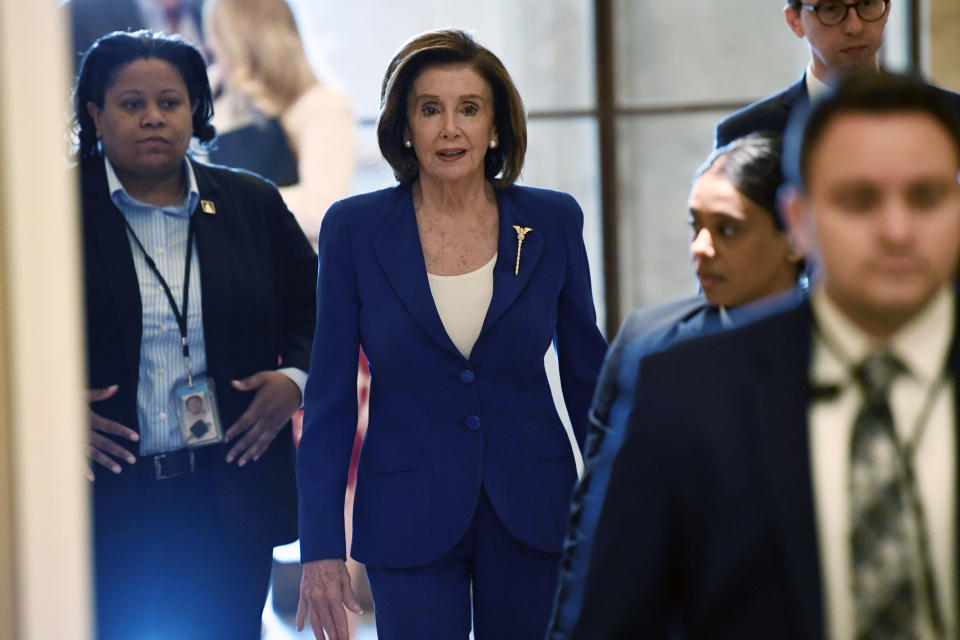Coronavirus stimulus package: What Congress unleashing fiscal firehose means for U.S. economy
Congress unleashed “the fiscal firehose.”
That’s how Wells Fargo analysts characterized the Senate’s $2 trillion stimulus package making its way to the House Friday. Pressured by the brutal economic impact of the coronavirus pandemic, the Senate, known for paralyzing bouts of political dysfunction, settled on a bipartisan path forward and passed the largest economic rescue package in U.S. history late Wednesday night.
Approximately $454 billion of that stimulus will be directed toward a Federal Reserve emergency lending program which could have the potential cumulative effect of amplifying the potential size of the emergency legislation to $6 trillion, according to Wells Fargo.
“The passage of this fiscal stimulus bill gives us reasonable confidence that another Great Depression is not in the cards, and that a healthy bounce back in economic growth will occur starting this fall,” wrote Wells Fargo analysts Michael Pugliese and Hop Matthews.
The $2 trillion fiscal stimulus package includes $1,200 checks or direct deposit payments to individuals, with an additional $500 for each child. According to Treasury Secretary Steven Mnuchin, those checks will go out in three weeks.

The rescue package also adds to current unemployment benefits such as extending aid by an additional 13 weeks and increasing weekly payments by $600. Gig workers and freelancers will also be able to collect unemployment checks for the very first time.
Hundreds of billions of dollars worth of aid will be doled out to corporate America: $350 billion in loans to small businesses, $500 billion in bailout money for companies, including airlines; $100 billion has also been set aside for the nation’s hospitals dealing with the surge in coronavirus patients.
The legislation also includes tighter restrictions on how businesses can use their bailout money. “If the small businesses keep their employees, retain them, then they don't have to actually pay back the loans, they become grants,” Sen. Kirsten Gillibrand (D-NY) told Yahoo Finance. Major corporations will also be barred from engaging in stock buybacks. “[There’s] a restriction that for two years, they can't pay dividends, do stock buybacks or increase CEO pay,” said Gillibrand.
While the passage of the emergency rescue plan is encouraging, the coronavirus pandemic will continue to wreak havoc on the U.S. economy.
“This is not to say that the policies are ill-designed, but rather that until the COVID-19 outbreak is in check, fiscal and monetary policymakers are just buying time,” wrote Pugliese and Matthews.
With total U.S. income standing at roughly $900 billion per month, Wells Fargo estimates that households and businesses will be able to use the fiscal boost to keep up with their financial obligations for only a few more months. Over 3 million people filed for unemployment benefits in the week ending March 21.
The estimates for the impact of the coronavirus outbreak on the economy continue to be stunning. Second-quarter contraction projections on an annualized basis range from 24%, according to Goldman Sachs, to 40% as forecasted by Capital Economics. Wells Fargo projects that the $2.4 trillion fiscal year 2020 budget deficit will be historic, the biggest it’s ever been as a share of the economy since World War II.
More from Sibile:
ER doc on coronavirus: ‘I’m on the front lines and I can tell you that we’re not at our peak yet’
Best thing was to lay off workers, says restaurant owner on coronavirus impact
Coronavirus causing labor market ‘meltdown on a scale never seen before’
Coronavirus will cost U.S. this many jobs by this summer
How the coronavirus outbreak is affecting your online food delivery
